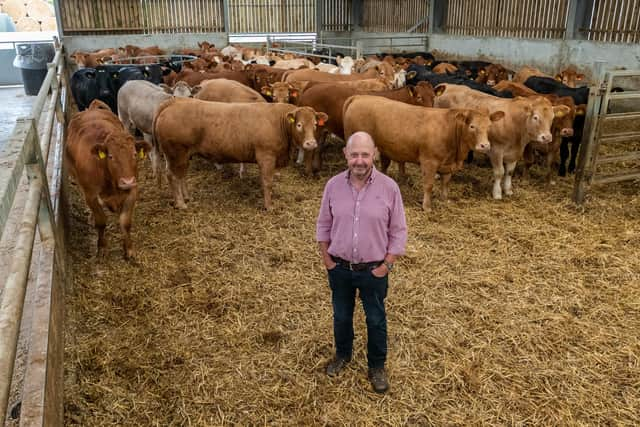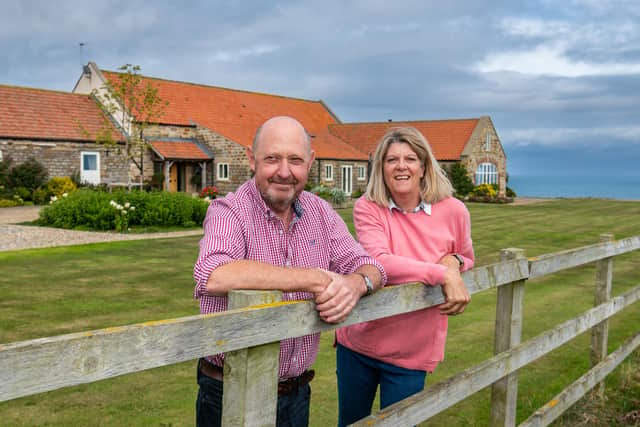Farm of the Week: 'Easiest harvest ever' finishes three weeks early on the Yorkshire coast
Joe Green has 900 acres of arable crops across his 1,200-acre farming enterprise run with his son Henry under the Green Farming banner from Fields Farm in Cloughton on a coastal strip down to Scalby Mills just a mile north of Scarborough.
Joe said he has never known a time like it. “We finished harvest three weeks early, in early August. It has been an amazing year because although our input costs have risen we can’t complain as we’ve had very little drying costs, I was fortunate when I bought my inputs and we have averaged nearly five tonnes per acre on first wheats as well as having strong market prices for grain. It has been the easiest, driest harvest we’ve ever had.
Advertisement
Hide AdAdvertisement
Hide Ad“I’ll not pretend I knew what was coming with increases to fertiliser prices as we tend to buy forward anyway. We use liquid nitrogen and we normally fill our tanks up this time of year, effectively forward buying, and the rest we fix a price for delivery in the spring for when we require it.


“I did that last year just before the gas thing really started to take off and before the war in Ukraine. Afterwards the price went mad, so it was the right thing to do. It’s always a really hard decision, but I’ve decided not to wait and have booked for next year now.”
Wheat makes up around half of Joe’s arable acreage and he said the crop is for either feed wheat or bioethanol.
“This year we had around 450 acres of winter wheat with first wheat varieties Extase & Parkin and seconds Gleam & Skyscraper. I like Parkin because it is a good early maturing wheat. We generally get 4 to 4 and a half tonnes off the first wheat, but a good harvest is what happens with second wheats.
Advertisement
Hide AdAdvertisement
Hide Ad“This year our yield monitor on the combine showed nearly 4 tonnes for seconds, which should put us around 4.3 tonnes per acre overall. We produce feed wheat because we have a lot of feed mills in this area and because there is demand from the bioethanol plants in Hull and on Teesside.”


Joe grows winter and spring barley and said the winter barley grown across 160 acres this year under a new venture has averaged a highly respectable 3.4 tonnes.
“We grew winter malting barley variety Electrum on contract to the Tadcaster Group for lager brewing for the first time. It is on a short-term contract at present.
“We also grow around 60-70 acres of spring malting barley variety Planet which goes into the distilling market as well as providing grain for our cattle.
Advertisement
Hide AdAdvertisement
Hide Ad“I don’t grow spring barley particularly by choice. I’ve added it to the rotation because of a problem with Brome in the past 15 years, which has come about for two reasons, having moved away from a plough-based system to more min-till and less chemical availability.


“It’s only in our barley and so, while we are min-till elsewhere, we are using the plough for it and where we know there is a bank of brome we put in a spring crop, let the brome germinate over the winter and then spray it off.”
Oilseed rape was grown across 200 acres this year and although Joe said he has problems with flea beetle his main problems come from other sources.
“Our main problems come from slugs or pigeons. Pigeons are a headache. Our land lies on a coastal strip from the A171 that runs into Scarborough. We’ve two villages and a lot of people living nearby, so we can’t use bangers.”
Advertisement
Hide AdAdvertisement
Hide AdThis year Joe has also let land out to Stockdales for growing seed potatoes. Joe classes the farm enterprise as arable with livestock. He has 200 acres of grazing and buys in cattle to fatten.
“We buy from beef breeding herds in Cumbria at around 12 months old in spring and autumn. I occasionally go to markets but have a good buyer in David Barker. We buy predominantly Limousin and Charolais. Those bought in spring will graze in summer, are housed in winter and sold at about 24 months. We finish about 250 in a 12-month period.
“We have just started with sheep again. We had a ewe flock years ago. When Henry came back home he fancied trying it. Two years ago we bought 150 gimmer lambs with the intention of keeping and selling breeding stock, but the market was so good we had to sell them. This year we ran gimmer lambs for a neighbour."
While ploughing is still undertaken for the barley Joe said he has seen how min-till and new technology has benefited the farm.
Advertisement
Hide AdAdvertisement
Hide Ad“We started moving away from the plough fourteen years ago and use a Sumo Trio. It has transformed our farm and I’m now taking oilseed rape towards direct drilling.
“Where we can, we direct drill into stubble. I’m all for it, but we are here to run a business to make a profit and the way to do that is to produce a big heap of corn so logistically I will always do what works.” Conservation plays its part too.
“We have been in ELS and HLS for the past 15 years and have 10-15 metre strips down the coastal path that includes part of the Cleveland Way. We grow wild bird and pollen nectar cover, have undertaken tree planting, hedgerow infill and field corners. We enjoy it, but It all has to stack up.
“Using a secondhand direct drill we have now planted 30 acres of cover crops, a mix of species including phacelia and raddish to increase soil vitality and add to the journey of improving soil structure increasing the natural drainage in our own soil.”
Advertisement
Hide AdAdvertisement
Hide AdJoe said it is very much a family farm, ever since his great grandfather Thomas moved to Court Green Farm in Cloughton from West Yorkshire in 1909.
“My wife Debbie is a farmer’s daughter from Norfolk. We met at Bishop Burton College. Debs looks after our DIY livery business and the farm records. Henry returned home and we now farm together, after having been an assistant farm manager in Norfolk and Goole. Our daughter Charlotte works in event management in London.
“We are tenants to the Duchy of Lancaster for most of our acreage and own 120 acres that my father, George Green, bought at Hayburn Wyke. “We are also tenants to 54 acres of cliff face, but funnily enough we’ve never tried harvesting it!